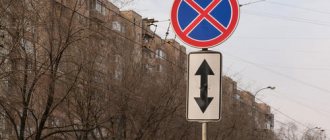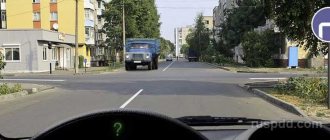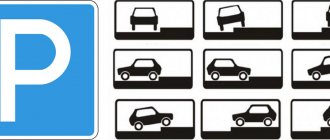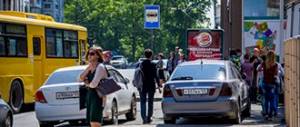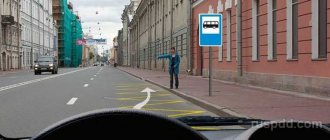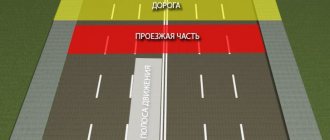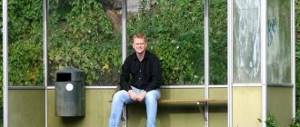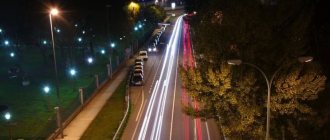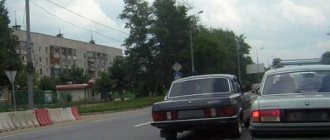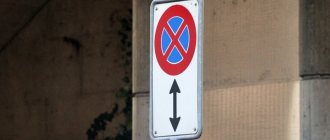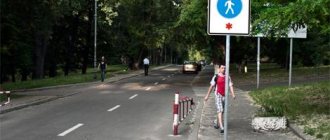Text of the Russian Traffic Regulations:
12.4. Stopping is prohibited:
- on tram tracks, as well as in the immediate vicinity of them, if this creates interference with the movement of trams;
- at railway crossings, in tunnels, as well as on overpasses, bridges, overpasses (if there are less than three lanes for traffic in a given direction) and under them;
- in places where the distance between a solid marking line (except indicating the edge of the roadway), a dividing strip or the opposite edge of the roadway and a stopped vehicle is less than 3 m;
- at pedestrian crossings and closer than 5 m in front of them;
- on the roadway near dangerous turns and convex breaks in the longitudinal profile of the road when the visibility of the road is less than 100 m in at least one direction;
- at the intersection of roadways and closer than 5 m from the edge of the roadway being crossed, with the exception of the side opposite the side passage of three-way intersections (crossroads) that have a continuous marking line or dividing strip;
- closer than 15 meters from the stopping places of fixed-route vehicles or parking for passenger taxis, indicated by marking 1.17, and in its absence - from the sign of the stopping place of fixed-route vehicles or parking for passenger taxis (except for stops for boarding and disembarking passengers, if this does not interfere with the movement of fixed-route vehicles vehicles or vehicles used as passenger taxis);
- in places where the vehicle will block traffic lights, road signs from other drivers, or make it impossible for other vehicles to move (enter or leave), or interfere with the movement of pedestrians.
- in the bike lane.
Let's take a closer look at the places where stopping is prohibited:
Stopping on overpasses, bridges, overpasses and under them is prohibited
This ban immediately provides an exception if stopping is allowed in a given direction for more than three lanes. The exception applies only when located on these objects. Stopping under overpasses and overpasses is prohibited.
As in previous cases, the traffic rules do not clearly define the boundaries of these road structures. They may be determined differently in each case by each inspector and each judge. Some along the sign with the name of the river, some along the fences of bridges, some at the beginning of the ascent, and so on.
Operation of stop and no parking signs
- sign 3.27 - stop and parking sign is prohibited;
- No parking sign with information signs
- signs 3.29 and 3.30 - no stopping sign (+ on even and odd days of the month + with information signs)
Area of operation of the stop and parking sign is prohibited
Area of operation of the “No Stopping” sign
Each of these signs imposes its own restrictions, which are more complex.
Rules for stopping and parking vehicles: video course
Stopping is prohibited if the interval is less than 3m to the opposite edge of the roadway
In this case, it should be noted that the tram tracks located in the middle, according to the definition of the Rules, are also one of the edges of the roadway
The traffic rules miss the point that two cars can park in one place at the same time, and at the same time there will be a very narrow passage, but this will not be considered a violation if the possibility of passage remains.
It is prohibited to stop at pedestrian crossings and within 5 m in front of them
Since stopping is also allowed on the left oncoming side of the road, a situation arises that it would seem possible to stop on the left side after passing a pedestrian crossing. This interpretation is not correct. “Before the crosswalk” should be interpreted relative to the intended direction of travel in the lane, not the actual direction of the vehicle. This is both logical and safe.
It is prohibited to stop at the intersection of roadways and closer than 5 m from the edge of the crossed roadway
Another case of the inability to unambiguously determine boundaries. Crossing roadways is not defined in the traffic rules. It is customary to determine boundaries along imaginary lines of continuation of the boundaries of each of the roadways. However, the technical curves of roadways also belong to the intersection and are intended for the movement of vehicles; accordingly, they are also a roadway and are included in the area of intersection of roadways. The line of the crossed roadway remains straight.
The exception is intersections at T-shaped intersections provided that there is a continuous marking line or dividing strip
Where is it prohibited to stop a vehicle?
The list of places where stopping vehicles is prohibited is given in paragraph 12.4 of the traffic rules. On the website Avtonauka.ru in section 12 of the traffic rules there are explanatory illustrations and comments on this section.
Here we will limit ourselves to a brief explanation of the provisions prohibiting stopping given in paragraph 12.4. Below are the provisions where stopping is prohibited, with an explanation of why it is prohibited, and also what should be done:
- on tram tracks, as well as in the immediate vicinity of them...;
The tram is “tied” to the rails, and it cannot go around a car stopped in violation. Moreover, in a collision between a tram and a non-tram, the non-tram will physically suffer more, and the tram may not even feel this impact.
— at railway crossings, in tunnels, as well as on overpasses, bridges, overpasses (if there are less than three lanes for traffic in a given direction) and under them;
At railway crossings, the circumstances are the same as in cases with trams. The train is big - it will move and you won’t feel it.
In tunnels, under bridges, overpasses and overpasses, space and visibility of the road are limited. Therefore, stopping in these places is prohibited.
On bridges, overpasses and overpasses, if the roadway in a given (your) direction has three or more lanes for traffic, stopping is not prohibited.
- in places where the distance between the solid “center” marking line, dividing strip or the opposite edge of the roadway and a stopped vehicle is less than 3 meters;
Three meters is usually enough so that another car can pass to the side of a stopped car without being disrupted, incl. freight, or, for example, a bus.
If the specified distance is less than three meters, then in order to pass a car that has violated the stopping rule, other drivers will be forced to cross the solid line or drive into the dividing strip, which is also a violation.
Those. a situation is created where one violator forces other traffic participants to violate. And this is wrong.
— at pedestrian crossings and closer than 5 m in front of them;
Stopping a car (vehicle) at a pedestrian crossing will interfere with the movement of pedestrians, and stopping in front of a pedestrian crossing creates a situation where the car (vehicle) with its dimensions will block the view of the pedestrian crossing for other drivers driving past.
Immediately BEHIND the pedestrian crossing, stopping is not prohibited, and you can stop your car.
- on the roadway near dangerous turns and convex breaks in the longitudinal profile of the road when the visibility of the road is less than 100 meters in at least one direction;
Near dangerous turns and convex breaks in the road profile, stopping on the roadway is prohibited due to limited visibility in these areas. Part of the road is hidden behind a bend or a break, and it is simply not visible. Stopping on the side of the road under the above conditions is not prohibited.
- at the intersection of roadways and closer than 5 m from the edge of the roadway being crossed, with the exception of the side opposite the side passage of three-way intersections (intersections) that have a continuous marking line or dividing strip;
Usually, 5 meters to the edge of the roadway being crossed (the pictures are in Section 12 of the Traffic Regulations) turns out to be a sufficient distance to bypass a stationary vehicle without violating the rules of stopping a car.
Stopping in front of the side passage of a T-intersection is permitted if the traffic lanes are separated by a solid marking line (or a dividing strip), and the distance between the “axial” solid line and the stopped vehicle is 3 meters or more.
- closer than 15 meters from the stopping places of fixed-route vehicles or the parking of passenger taxis, indicated by marking 1.17, and in its absence - from the sign of the stopping place of fixed-route vehicles or the parking of passenger taxis... ;
Stopping is prohibited closer than 15 meters from the stopping places of route vehicles in both directions, i.e. "before and after". The reference point is the installation location of one of the signs 5.16, 5.17, 5.18 or along the entire length of the road marking 1.17 (yellow zigzag).
Within 30 meters (15 meters “before” and 15 meters “after” the stop point indicator), only stopping to pick up (drop off) passengers is allowed, provided that the route vehicles do not interfere with traffic.
- in places where the vehicle will block traffic lights, road signs from other drivers, or make it impossible for other vehicles to move, or interfere with the movement of pedestrians (including people with limited mobility) ... ;
This provision does not require special interpretation. When choosing a place to stop, it calls for respect for other road users, including drivers of cars, bicycles, mopeds, motorcycles, etc., and pedestrians, including mobile and low-mobility categories of citizens.
— in the lane for cyclists.
Having “blocked” the traffic for cyclists, the stopped car becomes an obstacle for a two-wheeler, who will be forced to somehow go around this obstacle, incl. and along the roadway. The consequences can be very different.
It is prohibited to stop at places where route vehicles stop.
If the stopping place is marked with marking 1.17, stopping is prohibited within 15 meters before and after the marking.
If the stopping place is marked with a sign 5.17 or 5.18, then the prohibited zone is located at a distance of 15 meters before and after the sign.
The exception is a stop for boarding or disembarking passengers, in which case there should be no interference with route vehicles or passenger taxis
If the stopping place is not marked with a sign and/or markings, stopping is permitted.
It is not prohibited to stop on the opposite side of the road opposite the stopping place, even if the road width is less than 15 meters.
Penalty for stopping under a prohibitory sign in 2021
Based on Article 12.19 of the Code of Administrative Offenses of the Russian Federation, failure to comply with the rules of stopping a car without interfering with the movement of pedestrians and other vehicles is fraught with a warning or a fine of 500 rubles (compare: in Moscow and St. Petersburg - 2000 rubles).
Stopping in places reserved for disabled drivers is subject to a fine of 5,000 rubles.
Remember: to prevent the traffic inspector from fining you, your car must have a “disabled person” sign.
The fine for stopping in pedestrian crossing areas and public transport, in taxi ranks and on the sidewalk is 1,000 rubles.
Stopping on tram tracks, as well as further than the far right lane, violating the requirements of a prohibitory sign and road markings threatens with a sanction of one and a half thousand rubles.
The fine for stopping in a tunnel, in the second row, or for causing interference is 2,000 rubles. Stopping at a railway crossing – 1000 rubles or deprivation of rights for a period of 3 to 6 months. In case of repeated violation, the rights are revoked for 1 year.
In addition to collecting fines, the vehicle will be driven to an impound lot, so the offending driver will also have to pay for towing.
There are situations when the vehicle is standing still, but stopping movement is not considered a stop. This may occur in the following cases:
- when the prohibitory signal of a traffic controller or traffic light is turned on;
- in front of a pedestrian path, intersection, stop, when the passage of people or vehicles is implied;
- traffic jam.
In such cases, no penalties are imposed.
So, no stopping signs are very important. They need to be known, understood, but should not be ignored. This will allow drivers to avoid unpleasant consequences; Thus, they will not interfere with pedestrians or other vehicles.
